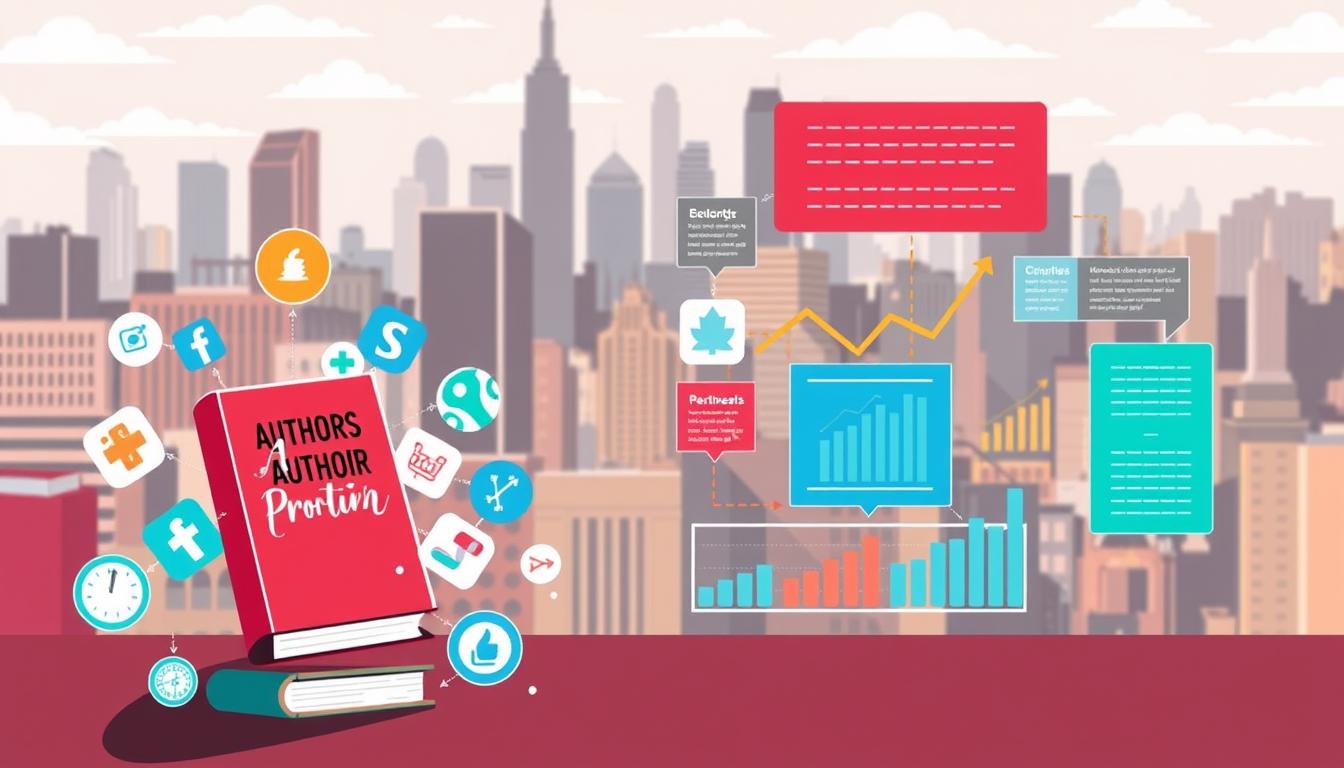Physical Address
304 North Cardinal St.
Dorchester Center, MA 02124
Physical Address
304 North Cardinal St.
Dorchester Center, MA 02124

Welcome to your roadmap for turning written work into a springboard for growth. Recent data reveals something powerful: 34% of entrepreneurs who publish double their income, while 72% land speaking opportunities and 74% gain valuable partnerships. But here’s the catch—most self-published titles sell fewer than 300 copies. Traditional publishing isn’t a guarantee either, with average sales around 3,000 copies. The difference? A strategic approach that prioritizes connection over transactions.
Gone are the days when success meant chasing sales numbers. Today’s authors use their work to build communities, spark conversations, and open doors to new ventures. This guide focuses on methods that align with how readers discover and engage with content in 2025. You’ll learn how to leverage emerging platforms, refine your online presence, and turn your title into a tool for long-term influence.
We’ve distilled insights from top performers into eight actionable areas. From optimizing retailer profiles to aligning with shifting social media trends, these tactics help you stand out in a crowded market. Ready to move beyond basic promotion? Let’s dive in.
Connecting with readers today means meeting them where they already spend time. Short-form video dominates attention spans, with platforms like TikTok and Instagram Reels driving authentic engagement. Take inspiration from authors like Colleen Hoover, whose casual behind-the-scenes clips and fan interactions have turned casual viewers into devoted fans.
Forget chasing viral dances – focus on content that reflects your unique voice. Share snippets of your creative process, highlight reader testimonials, or discuss themes from your work. These posts perform best when they feel conversational, not salesy.
Platforms like Twitter (now X) and Bluesky foster deeper connections through text-based discussions. Join niche communities on Reddit’s r/books or r/writing to share expertise organically. As shifting social media trends prioritize genuine interaction, prioritize quality over quantity.
Three rules for success:
Remember: Algorithms reward consistency, but audiences reward authenticity. Track what resonates using platform analytics, then double down on those formats.
Your digital presence acts as a 24/7 ambassador for your creative work. A polished website gives readers a central hub to explore your titles, while an email list keeps them engaged long after their first purchase. Consider this: authors who skip list-building lose 83% of potential repeat buyers, according to industry studies.

Top-performing sites like The Creative Penn blend resources with seamless navigation. Essential elements include:
Email platforms like MailChimp simplify campaign creation, but content quality determines success. Romance writer Alyssa Cole tripled her readers by offering free short stories – a tactic any genre can adapt. Try these lead magnets:
| Website Essentials | Email Tactics |
|---|---|
| Mobile-responsive design | Exclusive chapter previews |
| SEO-optimized copy | Personalized reading recommendations |
| Testimonial section | Behind-the-scenes updates |
Segment your list based on genre preferences or reading habits. This approach boosts open rates by 25%. Send monthly insights about your writing process or curated resources – not just sales pitches. As one NYT bestselling author notes: “Subscribers want connection, not constant promotion.”
Successful creators know that lasting impact comes from relationships, not receipts. While 78% of traditionally published works sell under 5,000 copies, entrepreneurial authors leverage their work to unlock high-value collaborations. Consider this: 74% gain referral partners through their content, while 34% double their income via speaking gigs and consulting.
Traditional approaches focus on units moved. Modern creators prioritize audience depth over sales volume. A title selling 100 copies to ideal readers often outperforms 1,000 random purchases. Why? Engaged fans become clients, collaborators, and brand ambassadors.
| Traditional Approach | Entrepreneurial Strategy |
|---|---|
| Focus on royalties | Monetize expertise through services |
| Broad audience targeting | Niche-specific community building |
| One-time transactions | Ongoing value delivery |
Three steps to transform your approach:
Case in point: Nonfiction writer Sarah Jones increased her consulting rates by 300% after positioning her title as a “conversation starter.” Her email list now drives 62% of premium service sales.
Track progress through partnership inquiries and audience retention – not just retailer rankings. As one industry leader notes: “Your words become currency when they build trust first.”
Smart promotion requires balancing cost and reach. Three platforms dominate for connecting with ideal readers: Facebook, BookBub, and Amazon. Each offers unique ways to turn casual browsers into loyal fans.

Facebook ads thrive on precise targeting. You can reach fans of specific authors, genres, or even TV shows tied to your themes. Start with $5 daily budgets to test images and headlines. One romance writer doubled her newsletter sign-ups by targeting fans of “Bridgerton”-themed content.
BookBub’s self-serve platform reaches readers already hunting for their next sale. Unlike their competitive featured deals, these promotions let you set bids based on clicks or impressions. Pair them with Amazon ads targeting high-intent shoppers browsing similar titles.
| Platform | Targeting Strength | Budget Tip | Best For |
|---|---|---|---|
| Interests/behaviors | $5/day tests | Building series fans | |
| BookBub | Genre preferences | CPM under $0.50 | Backlist titles |
| Amazon | Purchase intent | Focus on keywords | New releases |
Success hinges on lifetime value. If 10% of first-time buyers purchase your next work, your effective cost per acquisition drops. As industry expert Mark Dawson notes: “Ads aren’t about immediate sales—they’re investments in relationships that compound over time.”
Boost results by retargeting website visitors or email subscribers. Facebook’s lookalike audiences help find readers similar to your top fans. Track metrics beyond initial sale—focus on newsletter sign-ups and repeat purchases.
Your Amazon success hinges on two critical choices most creators overlook. Selecting precise categories and keywords determines whether your work gets buried or discovered by eager readers. These tools act as search magnets, guiding your ideal audience straight to your title.
Many authors make three costly mistakes: picking broad genres like “Thriller,” using only one category slot, or ignoring subcategory opportunities. Instead, drill down to specific niches. A mystery novel about baking enthusiasts performs better in “Culinary Cozy Mysteries” than general fiction lists.
| Common Pitfalls | Smart Solutions |
|---|---|
| Choosing 1-2 categories | Use all 10 allowed slots |
| Generic keywords (“love story”) | Long-tail phrases (“second-chance ranch romance”) |
| Copying competitor categories | Analyzing traffic vs. competition |
Keywords serve as invisible guideposts. Research terms your readers actually type into search bars. Tools like Publisher Rocket reveal high-traffic, low-competition options. As founder Dave Chesson notes: “Writers who target ‘vegan meal prep guides’ outsell those chasing ‘cookbooks’ every time.”
Always align choices with your content’s core themes. Misleading tags might boost short-term visibility but damage reader trust. Track category rankings weekly and adjust keywords quarterly to match evolving search trends.
Breaking into today’s literary scene demands fresh approaches that blend tech-savvy outreach with authentic connection. Virtual launches on platforms like Zoom or YouTube Live let you host global gatherings without travel costs. Andy Weir’s Project Hail Mary event demonstrated this power, mixing live readings with fan Q&As that boosted pre-orders and loyalty.
Collaborating with BookTok creators unlocks niche audiences, especially for romance or YA genres. These influencers thrive on sharing heartfelt recommendations, turning hidden gems into viral hits. Partner with 3-5 micro-influencers whose followers match your ideal reader profile.
AI tools streamline content creation while maintaining your unique voice. Draft blog posts or social captions faster with ChatGPT, then add personal flair. For audiobooks, services like ACX offer affordable narration options – a growing format that reaches 25% more listeners than traditional methods.
Three steps to implement today:
Success lies in balancing innovation with genuine interaction. As platforms evolve, staying adaptable ensures your work resonates where attention flows next.